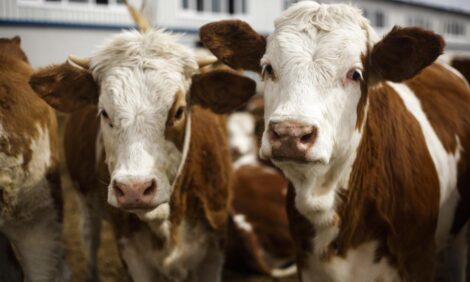



Phosphorus balance disorders in dairy cows
The period of greatest risk for phosphorus balance disorders is during the first weeks of lactationEditor's note: article includes excerpts from a presentation by Walter Grünberg, DVM, PhD, Justus-Liebig University, Giessen, German, during the 2023 Tri-State Dairy Nutrition Conference.
Phosphorus (P) deprivation in early lactation is generally a result of high milk yield in combination of either diets with inadequately low P content, insufficient access to feed, or feed intake depression as it may occur in sick animals.
Lactating cows excrete large amounts of P through the mammary gland. Phosphorus loss through the udder presents a challenge, particularly at the onset of lactation. The combination of the sudden onset of milk production and the low dry matter intake around calving present metabolic challenges that have the potential to overwhelm counter regulatory mechanisms.
Phosphorous deficiency
A variety of clinical presentations have been associated with hypophosphatemia or P deficiency in cattle. These presentations do not consistently occur in all animals showing hypophosphatemia or P deprivation and in many cases are not experimentally reproducible.
The main challenge in determining the deleterious effects of P balance disturbances is the lack of suitable diagnostic parameters for this purpose. The concentration of P in serum or plasma is the established standard for diagnosing P balance disturbances. Phosphorus in serum or plasma is a decent reflection of the short-term P supply, but a poor indicator of the total P balance in the body. This parameter is furthermore affected by factors that are not directly related to the P balance of the body, including diurnal effects, feed intake, hydration status, acid-base balance, or carbohydrate metabolism.
Hypophosphatemia is mainly diagnosed in cows in early lactation, which is also the period with the highest disease incidence. In many instances, it remains uncertain if hypophosphatemia is causing or at least contributing to the observed clinical presentation, if it is consequence rather than cause of the disease, or if periparturient hypophosphatemia is just a sign of adaptation to lactation of the fresh cow and is entirely unrelated to the diagnosed disease.
Feed intake depression
Anorexia or feed intake depression is the most consistent symptom associated with P deficiency across species. The mechanism through which P deprivation supply hampers voluntary feed intake has not been elucidated. In ruminants, impaired rumen fermentation activity in states of P deprivation was proposed as a possible cause for anorexia, a mechanism that however does not explain similar symptoms observed in a variety of non-ruminant species when P deprived.
Long episodes of restricted dietary P supply of months or even years are well documented to result in reduced dry matter intake. Feed intake depression was also observed after shorter periods of P deprivation in transition dairy cows. Dairy cows that were on a restricted P supply from 4 weeks before to 4 weeks after calving (diets with 0.16% P in DM before, and 0.20% P in DM after calving) did not increase their dry matter intake after the first week of lactation.
In contrast, cows where restricted P supply was discontinued at the time of calving did not show a reduced dry matter intake (Wächter et al., 2022a). These results suggest that restricted dietary P supply, particularly when occurring in the fresh cow period, has the potential to result in feed intake depression.
Postparturient hypophosphatemia
Postparturient hypophosphatemia is defined as the decline of the P concentration in serum or plasma that is observed in the majority of clinically healthy dairy cows during the first hours, days, and even weeks of lactation. This presentation should be differentiated from hypophosphatemia occurring in sick fresh cows because the etiology of hypophosphatemia in these cases is likely to be different.
A large-scale metabolic profiling study (including over 7000 dairy cows) reported hypophosphatemia ([Pi] < 3.9 mg/ dL) occurring in 71%, 21%, and 10% of healthy fresh cows on the 1st, 3rd, and 5th day of lactation, respectively (Hansen, 2018). It remains unresolved whether transient postparturient hypophosphatemia that is devoid of any clinical symptoms is just part of the physiologic adaption process to lactation, or if it should rather be seen as a harbinger for more severe metabolic disturbances to come.
Postparturient hemoglobinuria
Postparturient hemoglobinuria (PPH) is characterized by intravascular hemolysis predominantly occurring in multiparous dairy cows in their first weeks of lactation. The disease occurs as sporadic but potentially lethal disease affecting only a minority of cows in a herd, even when the majority of fresh cows display hypophosphatemia.
It was only recently that PPH could be induced experimentally by P depriving animals during the transition period in a controlled study (van den Brink et al., 2023). This study reported the existence of a subclinical form of the disease characterized by pronounced intravascular hemolysis occurring in a subset of P deprived cows that was, however, not severe enough to result in hemoglobinuria.
Impaired fertility
Impaired growth and poor fertility were historically among the first signs attributed to inadequate P supply in ruminants. Current wisdom states that negative effects on fertility or weight gain are not directly caused by deficient P supply, but rather by inadequate energy and nutrient intake resulting from feed intake depression. Feeding P in excess of requirements has no beneficial effect on growth or fertility, nonetheless poor fertility remains a common justification to feed P in excess of current recommendations.
Downer cow syndrome
P deficiency has been incriminated for decades as a cause of this clinical presentation. Affected cows are typically in early lactation, mentally alert with posture suggesting hind limb paresis, and do not respond to intravenous treatment with calcium salts. A consistent finding in affected animals is hypophosphatemia that may or may not be associated with hypocalcemia. While P depletion and hypophosphatemia can be experimentally induced without much effort, there is to this date not one single documented case of experimentally induced hypophosphatemic recumbency in cattle.
Summary
Recommendations for dietary P supply to lactating cows are adequate for fresh cows, and P deprivation limited to the dry period facilitates rather than complicates adaptation of the P homeostasis to lactation. Combining dietary P deprivation with the sudden losses of P through the mammary gland at the onset of lactation, and the low dry matter intake around calving has the potential to overwhelm the cows.
Depending on the presence of other metabolic disturbances commonly encountered in fresh dairy cows, the effect of P deprivation or hypophosphatemia and the ensuing clinical presentation may vary from animal to animal.
Every effort should be made to avoid P deprivation in this critical period of lactation.



